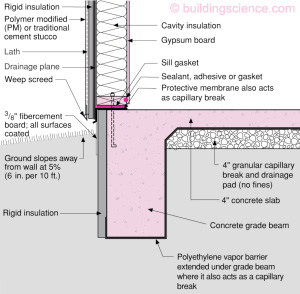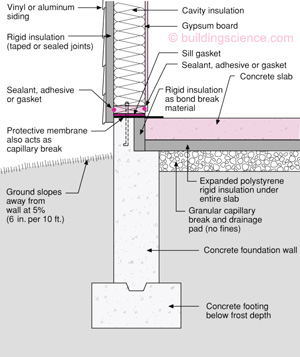In climates where the average monthly temperature for the coldest month of the year goes below 45°F, the temperature of the slab perimeter may be below the dew point of interior air for a significant period of time.
Even when condensation conditions are not present on the slab surface, relatively cool temperatures near an uninsulated slab edge will tend to elevate the local relative humidity. As relative humidity rises above acceptable human control conditions (30-60% RH), so too do the risks associated with mold and mildew, fungal growth, dust mites and other pests. This is a particular concern for carpeted slabs as these tend to also provide media and cover for “biologicals.”
Adding insulation outside of the slab edge will allow the inside surface temperature of the slab perimeter to more closely track interior conditions thereby reducing the potential for condensation and elevated relative humidity. The strategies available for insulating the slab edge depend upon whether the slab on grade is 1) monolithic with a grade beam, or 2) supported on grade and independent of the foundation wall.
When the slab is monolithic with a grade beam, the insulation must be installed to the exterior of the slab edge/grade beam and continue vertically to the bottom of the grade beam as shown in the example to the right. The insulation material must be appropriate for ground contact. XPS, rigid fiberglass and rock wool are examples of acceptable materials. The exterior insulation will need to be protected from impact damage during construction and, subsequently, the above grade portion must be protected from UV and impact damage on the above grade portion.
When the slab is independent from a perimeter foundation wall, insulation may be installed either on the exterior of the foundation wall or between the foundation wall and the slab. In order for the slab to be independent of the foundation wall, a bond break is needed between the slab, which is supported on grade, and the foundation wall that supports the exterior wall structure and its loads. Insulation at the vertical slab edge and under the slab perimeter provides this bond break. The diagram to the right shows and example of a slab on grade that is structurally and thermally isolated from the perimeter foundation wall. Limiting factors on the width of the slab edge insulation in this situation are determined by attachment of floor finishes and width of foundation wall needed to support the wall structure.
Whenever insulation is used in contact with ground or near ground, appropriate insect control measures must be used. Appropriate measures will vary by location.
Slab Edge Insulation Details
Figure 1
Perimeter Insulation of Monolithic Slab-Grade Beam
- Insulation extends to bottom of grade beam
- Protection board over above grade portion of rigid insulation
- Protection board of non-water sensitive material and coated to control absorption of water
- Protective membrane adhered to slab and wrapped over top of insulation
- Insulation material non-moisture sensitive and not subject to degradation with ground contact
Figure 2
Slab-on-Grade Independent of Perimeter Foundation Wall
- Slab is insulated vertically at the edge and horizontally at the perimeter or under the entire slab
- Rigid insulation provides bond break between slab and foundation wall
- Protective membrane adhered to both slab and top of foundation wall


